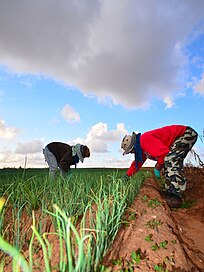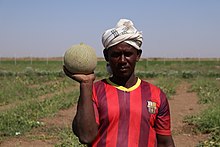


In macroeconomics, the labor force is the sum of those either working (i.e., the employed) or looking for work (i.e., the unemployed):

Those neither working in the marketplace nor looking for work are out of the labor force.[1]
The sum of the labor force and out of the labor force results in the noninstitutional civilian population, that is, the number of people who (1) work (i.e., the employed), (2) can work but don't, although they are looking for a job (i.e., the unemployed), or (3) can work but don't, and are not looking for a job (i.e., out of the labor force). Stated otherwise, the noninstitutional civilian population is the total population minus people that could not work (children, elders, soldiers, incarcerated). The noninstitutional civilian population is the number of people potentially available for civilian employment.

The labor force participation rate is defined as the ratio of the labor force to the noninstitutional civilian population.

Instead, within a company, its value can be labelled as its "Workforce in Place".

Formal labour is any sort of employment that is structured and paid in a formal way. They are paid formally using payrolls paper, electronic card and alike. [2] Unlike the informal sector of the economy, formal labour within a country contributes to that country's gross national product. Informal labour is labour that falls short of being a formal arrangement in law or in practice. Labour inherit may come as formal or non-formal, an employee old enough but below retirement age bracket passing on to his children. [3] It can be paid or unpaid and it is always unstructured and unregulated.[4] Formal employment is more reliable than informal employment. Generally, the former yields higher income and greater benefits and securities for both men and women.[5]
The contribution of informal labourers is immense. Informal labour is expanding globally, most significantly in developing countries.[6] According to a study done by Jacques Charmes, in the year 2000 informal labour made up 57% of non-agricultural employment, 40% of urban employment, and 83% of the new jobs in Latin America. That same year, informal labour made up 78% of non-agricultural employment, 61% of urban employment, and 93% of the new jobs in Africa.[7] Particularly after an economic crisis, labourers tend to shift from the formal sector to the informal sector. This trend was seen after the Asian economic crisis which began in 1997.[6]

Gender is frequently associated with informal labour. Women are employed more often informally than they are formally, and informal labour is an overall larger source of employment for females than it is for males.[5] Women frequent the informal sector of the economy through occupations like home-based workers and street vendors.[6] The Penguin Atlas of Women in the World shows that in the 1990s, 81% of women in Benin were street vendors, 55% in Guatemala, 44% in Mexico, 33% in Kenya, and 14% in India. Overall, 60% of women workers in the developing world are employed in the informal sector.[2]
The specific percentages are 84% and 58% for women in Sub-Saharan Africa and Latin America respectively.[2] The percentages for men in both of these areas of the world are lower, amounting to 63% and 48% respectively.[2] In Asia, 65% of women workers and 65% of men workers are employed in the informal sector.[2] Globally, a large percentage of women that are formally employed also work in the informal sector behind the scenes. These women make up the hidden work force.[2]
According to a 2021 FAO study, currently, 85 per cent of economic activity in Africa is conducted in the informal sector where women account for nearly 90 per cent of the informal labour force.[8] According to the ILO's 2016 employment analysis, 64 per cent of informal employment is in agriculture (relative to industry and services) in sub-Saharan Africa.[9][8] Women have higher rates of informal employment than men with 92 per cent of women workers in informal employment versus 86 per cent of men.[9][8]
Formal and informal labour can be divided into the subcategories of agricultural work and non-agricultural work. Martha Chen et al. believe these four categories of labour are closely related to one another.[10] A majority of agricultural work is informal, which the Penguin Atlas for Women in the World defines as unregistered or unstructured.[2] Non-agricultural work can also be informal. According to Martha Chen et al., informal labour makes up 48% of non-agricultural work in North Africa, 51% in Latin America, 65% in Asia, and 72% in Sub-Saharan Africa.[5]
Agriculture and informal economic activity are among some of the most important sources of livelihood for women.[8] Women are estimated to account for approximately 70 per cent of informal cross-border traders[11] and are also prevalent among owners of micro, small, or medium-sized enterprises (MSMEs).[8] MSMEs are more vulnerable to market shocks and market disruptions. For women-owned MSMEs this is often compounded by their lack of access to credit and financial liquidity compared to larger businesses.[8] However, MSMEs are often more vulnerable to market shocks and market disruptions.[8] For women-owned MSMEs, this is often compounded by their lack of access to credit and financial liquidity compared to larger businesses[8].


Afarmworker, farmhand or agricultural worker is someone employed for labor in agriculture. In labor law, the term "farmworker" is sometimes used more narrowly, applying only to a hired worker involved in agricultural production, including harvesting, but not to a worker in other on-farm jobs, such as picking fruit.
Agricultural work varies widely depending on context, degree of mechanization and crop. In countries like the United States where there is a declining population of American citizens working on farms — temporary or itinerant skilled labor from outside the country is recruited for labor-intensive crops like vegetables and fruits.


Paid and unpaid work are also closely related with formal and informal labour. Some informal work is unpaid, or paid under the table.[10] Unpaid work can be work that is done at home to sustain a family, like child care work, or actual habitual daily labour that is not monetarily rewarded, like working the fields.[2] Unpaid workers have zero earnings, and although their work is valuable, it is hard to estimate its true value. The controversial debate still stands. Men and women tend to work in different areas of the economy, regardless of whether their work is paid or unpaid. Women focus on the service sector, while men focus on the industrial sector.
Women usually work fewer hours in income generating jobs than men do.[5] Often it is housework that is unpaid. Worldwide, women and girls are responsible for a great amount of household work.[2]
The Penguin Atlas of Women in the World, published in 2008, stated that in Madagascar, women spend 20 hours per week on housework, while men spend only two.[2] In Mexico, women spend 33 hours and men spend 5 hours.[2] In Mongolia the housework hours amount to 27 and 12 for women and men respectively.[2] In Spain, women spend 26 hours on housework and men spend 4 hours.[2] Only in the Netherlands do men spend 10% more time than women do on activities within the home or for the household.[2]
The Penguin Atlas of Women in the World also stated that in developing countries, women and girls spend a significant amount of time fetching water for the week, while men do not. For example, in Malawi women spend 6.3 hours per week fetching water, while men spend 43 minutes. Girls in Malawi spend 3.3 hours per week fetching water, and boys spend 1.1 hours.[2] Even if women and men both spend time on household work and other unpaid activities, this work is also gendered.[5]
In the United Kingdom in 2014, two-thirds of workers on long-term sick leave were women, despite women only constituting half of the workforce, even after excluding maternity leave.[12]
The global supply of labor almost doubled in absolute numbers between the 1980s and early 2000s, with half of that growth coming from Asia.[13] At the same time, the rate at which new workers entered the workforce in the Western world began to decline. The growing pool of global labor is accessed by employers in more advanced economies through various methods, including imports of goods, offshoring of production, and immigration.[14] Global labor arbitrage, the practice of accessing the lowest-cost workers from all parts of the world, is partly a result of this enormous growth in the workforce. While most of the absolute increase in this global labor supply consisted of less-educated workers (those without higher education), the relative supply of workers with higher education increased by about 50 percent during the same period.[14] From 1980 to 2010, the global workforce grew from 1.2 to 2.9 billion people. According to a 2012 report by the McKinsey Global Institute, this was caused mostly by developing nations, where there was a "farm to factory" transition. Non-farming jobs grew from 54 percent in 1980 to almost 73 percent in 2010. This industrialization took an estimated 620 million people out of poverty and contributed to the economic development of China, India and others.[15]

Under the "old" international division of labor, until around 1970, underdeveloped areas were incorporated into the world economy principally as suppliers of minerals and agricultural commodities. However, as developing economies are merged into the world economy, more production takes place in these economies.[16] This has led to a trend of transference, or what is also known as the "global industrial shift ", in which production processes are relocated from developed countries (such as the US, European countries, and Japan) to developing countries in Asia (such as China, Vietnam, and India), Mexico and Central America. This is because companies search for the cheapest locations to manufacture and assemble components, so low-cost labor-intensive parts of the manufacturing process are shifted to the developing world where costs are substantially lower.
But not only manufacturing processes are shifted to the developing world. The growth of offshore outsourcing of IT-enabled services (such as offshore custom software development and business process outsourcing) is linked to the availability of large amounts of reliable and affordable communication infrastructure following the telecommunication and Internet expansion of the late 1990s.[17]
{{cite web}}: CS1 maint: archived copy as title (link).
(chapter) COMMUNICATION AND OUTSOURCING ... Roche, 1998
![]() This article incorporates text from a free content work. Licensed under CC BY-SA 3.0 (license statement/permission). Text taken from Seizing the opportunities of the African Continental Free Trade Area for the economic empowerment of women in agriculture, FAO, FAO.
This article incorporates text from a free content work. Licensed under CC BY-SA 3.0 (license statement/permission). Text taken from Seizing the opportunities of the African Continental Free Trade Area for the economic empowerment of women in agriculture, FAO, FAO.